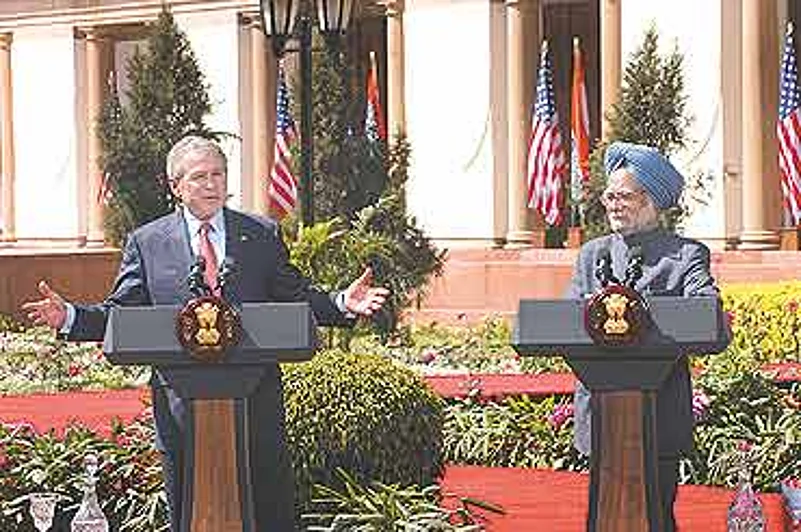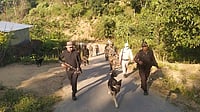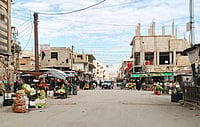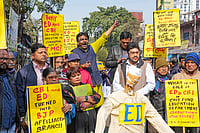It was an hour of waiting for the others: secretary of state Condoleezza Rice was in one room with a gaggle of US officials, sipping tea; in a third room were defence minister Pranab Mukherjee, commerce minister Kamal Nath, Kapil Sibal, the minister appointed to wait on Bush. It was in the fourth room that hectic negotiations and bargains were under way. At the table there, among others, sat national security advisor M.K. Narayanan, secretary, Department of Atomic Energy, Dr Anil Kakodkar, and principal secretary T.K.A. Nair, smoothening out with the American team the remaining wrinkles on the Indo-US civilian nuclear deal that the two teams hadn’t managed to iron out through the long March 1-2 night.
An hour later, Manmohan and Bush summoned them to the Deccan Suite. Once they were seated, the PM recapitulated the discussion he had had with the US president. With Manmohan completing the narration, Bush said, "The prime minister and I agreed that the Indo-US relationship is more than just this nuclear deal. And I do not know what you guys have decided. But I was telling the prime minister that the relationship means more than the nuclear stuff."
Sitting next to Bush was Rice. She broke the good news, "Mr President, we have an agreement."
Bush looked around, smiled and said, "Great." A man of few words, Manmohan too broke into a smile, as did all those around. Exuberantly, Bush talked on other issues to his audience. The PM then turned to Sharad Pawar, agriculture minister, and asked, "Would you like to say something?" Pawar spoke, then Pranab, Kamal Nath and Kapil Sibal followed suit.
Down the row, in the last chair, sat Kakodkar, the man who had publicly spoken against the advisability of placing the fast breeder reactors under safeguards—and consequently perceived, rather erroneously, as an opponent of the Indo-US nuclear deal. Manmohan pointed at him and said, "Mr President, that is Dr Kakodkar, secretary of our Department of Atomic Energy." To him, too, the PM asked, "Would you like to say something?"
Kakodkar looked surprised, as officials on such occasions are rarely asked to speak. Kakodkar said, "Sir, we have a good agreement. I am very happy."

At this Bush quipped, "I’m glad you like it." There was laughter all around. It was, in a way, a release for the pent-up pressure of conducting tortuous negotiations over months, that alternately stoked expectations and dashed hopes of cobbling together an agreement between New Delhi and Washington on India’s plan to separate its military facilities from the civilian.
"So it’s done," a relieved voice echoed in the room.
One fault Bush doesn’t suffer from is lack of candour, that rare ability to call a spade a spade. "What’s done is the beginning of what will be done," he quipped, explaining, "You know, Mr Prime Minister, I have first to go to the US Congress and then we go to the NSG (Nuclear Suppliers Group) and then we go to the IAEA (International Atomic Energy Agency)." Bush paused, looked around and dramatically declared, "And then it will be done."
On the sun-drenched lawns of Hyderabad House Manmohan and Bush stepped out, 90 minutes from the time they had begun their chat. To the media, Manmohan announced: "I’m particularly pleased that we have reached an understanding on the implementation of our agreement on civil nuclear cooperation of July 18, 2005. I have conveyed to the president that India has finalised the identification of civilian facilities to which we had committed." Manmohan said the president was to now approach the US Congress to amend US laws and the NSG to adjust its guideline; that India will discuss with the IAEA a safeguards agreement specific to his country. "You will appreciate I cannot say more now, while our Parliament is in session." In conclusion, he added, "Our discussions today make me confident that there are no limits to the Indo-US partnerships."
The media interaction was brief. One of the questions the president fielded, though, cut to the chase. "What kind of message does it send to other countries that are in the process of developing nuclear technology? Why should they sign the NPT if India is getting a deal without doing so?"

Bush’s response is the most categorical evidence of the impending changes in the nuclear club: "What this agreement says is things change, times change...." He said the deal was a difficult one to sell to Congress, but he was confident of success as it was "in the interest of the United States, and at the same time make it clear that there’s a way forward for other nations to participate in...civilian nuclear power in such a way as to address non-proliferation concerns. I’m trying to think differently, not to stay stuck in the past, and recognise that by thinking differently, particularly on nuclear power, we can achieve some important objectives, one of which is less reliance on fossil fuels."
Despite the nervousness in Delhi, the deal seemed a distinct possibility after the PM made a statement in Parliament on February 27—just two days before Bush was to arrive in India. Spelling out the broad contours of the separation plan, Manmohan declared that the fast breeder reactors won’t be placed under safeguards. He further added, "Our proposed separation plan entails identifying in phases a number of our thermal nuclear reactors as civilian facilities to be placed under IAEA safeguards, amounting to roughly 65 per cent of the total installed thermal nuclear power capacity, by the end of the separation plan. A list of some other dae facilities may be added to the list of facilities within the civilian domain. The separation plan will create a defined civilian domain where IAEA safeguards apply." (The last act of separation is expected, under the plan, to happen in 2014.)
The PM said that discussions with the US "have focused on four critical elements: the broad contours of a separation plan; the list of facilities being classified civilian; the nature of safeguards applied to facilities listed in the civilian domain; and the nature and scope of changes expected in US domestic laws and NSG guidelines to enable full civilian nuclear energy cooperation with India."

Four and a half hours after his speech in Parliament, Manmohan received a call from US secretary of state Rice. She had already read the speech, and discussed it with her colleagues. She told the PM that the "deal was doable". Sources say that in an earlier discussion with Rice, he had told her, "You have to win over the trust of our scientific establishment. Two generations of scientists have grown up under US sanctions. They have seen the US cooperate more with a country like China, while the Indians have been subjected to a variety of denials, from visas to technology." That message seems to have gone home. And the message had an edge to it as both Manmohan and Rice were convinced that the way forward was to reduce the world’s dependence on fossil fuels—precisely what civil nuclear energy promises.
Yet, before Bush’s arrival in Delhi, two issues still remained to be resolved: one, the nature of safeguards that India could accept; two, whether these safeguards would apply to reactors which are not even on the drawing board yet.
"The last lap was very hard," says a source. "A lot of effort had to be put in. And we managed to come up with the parameters of an agreement. The US is very pleased with the separation plan and believes it can be taken to Congress and an exemption secured for India and India alone." Sources say the Indian effort was to get a language into the understanding which would, without ambiguity, make it clear that India alone had the right to determine the nature of future reactors, whether military or civilian, other than those 22 (that is, 15 currently in operation plus the seven under construction) under discussions at the moment. This was considered vital as it would allow India to construct a military reactor should it deem it necessary for future strategic interests. In other words, India wasn’t willing to accept a cap on its nuclear programme.

The safeguards issue presented a peculiar problem: should it be applicable in perpetuity? The perpetuity clause was introduced by Robert Joseph, under secretary of state for arms control and international security, in his remarks to the Senate Foreign Relations Committee on November 2. Joseph said safeguards must be applied in perpetuity to bolster the confidence of the US and others to supply nuclear fuel to India and also meet their obligations under the NPT.
This was contrary to what the prime minister had declared to Parliament on July 29 last year, claiming that "India will never accept such discrimination". The nuclear club imposes safeguards in perpetuity on those states that are not nuclear weapon states under the NPT. New Delhi argued that it had no problem in putting reactors under safeguards as long as there was supply of nuclear fuel. Without this, the Manmohan government would be vulnerable to criticisms that it had set itself up for another Tarapur incident (when the US unilaterally stopped fuel to the Tarapur plant after India’s peaceful nuclear explosion in 1974). Though India had no intention of walking out of safeguards, this assurance was vital to win the support of Parliament and people for the deal. The US accepted India’s argument: India can walk out of the safeguards if the supply of nuclear fuel ceases from one country, and a replacement source can’t be found.
The discussion also saw the US concede that New Delhi was not in a position to accept safeguards applicable to a non-nuclear weapon state. The nature of an appropriate safeguard agreement will have to be negotiated with the IAEA, which will take into account India’s de-facto nuclear status. Yet, New Delhi will not be able to get exactly the same terms that nuclear weapon states under the NPT regime enjoy. But it is a half-way house.
The next step will see the PM sharing the separation plan with Parliament. The US will take the separation plan to Congress, which has to make an India-specific exemption in its legislation (by amending Section 123 of the US Atomic Energy Act) that will then lead to an Indo-US nuclear agreement. The US will also encourage the NSG to amend its guidelines to allow full-scope nuclear commerce with India in the civil domain. The NSG meets twice a year, in May and October.
Although the sequencing of each step and the timelines are not yet public, and it isn’t certain when such an agreement would become feasible, sources say the Americans are working on the principle of "the sooner the better". For this round at least, you could applaud the Manmohan government’s navigation skills.

























